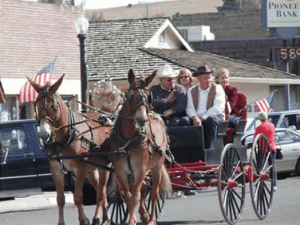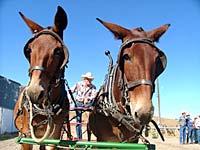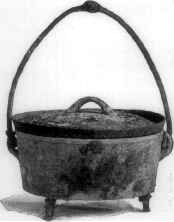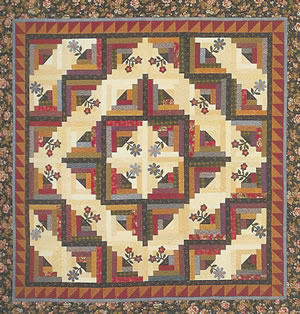
Muleskinner Blue Skies: The Wallowas in summer as seen from the Hells Canyon National Recreation Area. Wikimedia Commons.
While all you young buckaroos are heading into cowboy country for the 99th annual Pendleton Round-Up and Happy Canyon Pageant starting Wednesday, Mr. Scatter will be stuck inside of Portland with the Round-Up Blues again. I’ll be missing the roping, the trick riding, the bronc busting, the prodigious after-hours cheap bourbon guzzling, and all those other enduring arts of the untamed West.
So last weekend, on a trip to Enterprise in the Wallowa Mountains — 100-odd miles east of Pendleton, which put me really into ranch country — I compensated by heading for the Wallowa County Fairgrounds and the 29th annual Hells Canyon Mule Days.
 Yes, Mule Days. As in Harry S Truman. As in Francis the Talking. As in 20 Mule Team Borax. As in stubborn as a. As in Bing Cosby’s tune about “an animal with long funny ears” whose “back is brawny and his brain is weak” — a gross misrepresentation of this hardworking beast, which is indeed brawny but is anything but weak-minded: It’s much too smart to give in to a mere human being without a fight.
Yes, Mule Days. As in Harry S Truman. As in Francis the Talking. As in 20 Mule Team Borax. As in stubborn as a. As in Bing Cosby’s tune about “an animal with long funny ears” whose “back is brawny and his brain is weak” — a gross misrepresentation of this hardworking beast, which is indeed brawny but is anything but weak-minded: It’s much too smart to give in to a mere human being without a fight.
Sitting in the grandstands and watching the curious backward dance of one unhappily saddled pack animal, I got the very strong feeling that mules are not meant for racing. And I reached the inescapable conclusion that, whatever else the mule’s multiple virtues, there is something inescapably comic — Sisyphean, even — about trying to coax it into performing the sort of rodeo tricks that seem like catnip to a horse.
This particular beast was a stocky, handsome, muscular white specimen of the species, and I have no doubt that when called upon it can haul its weight in moonshine over tricky terrain. But when its rider tried to coax it to the white chalk starting line for the pole bending competition, the mule instead shied from the bit and stepped back, back, backward, arching its neck and tossing its head in protest, until it rammed its rump into the rail that separates the field from the track. Minding its so-called “master” was not on its agenda on this Sunday afternoon.
Oddly, I admired the beast.
Mule Days here in Enterprise, in the gorgeous high country of far northeastern Oregon that is still rightly lamented by the Nez Perce Indians who were run off their land 130 years ago by the U.S. Cavalry, offer a lot of other attractions. A Dutch oven cooking competition. A quilt exhibition. Cowboy poets. Hand-tooled saddles and other western gear for sale. Unending country music over the loudspeakers. All the fairground snacks your stomach can handle.
But people, keep your eyes on the main event here: galloping mules!
 This is not the Sport of Kings, with sleek beauties like Secretariat to give an aesthetic gloss to the gambling and occasional gore. This is mules, the sterile offspring of male donkeys and female horses, who are strong and capable but also awkward and funny-looking, with heads too big for their bodies and ears too long for their heads.
This is not the Sport of Kings, with sleek beauties like Secretariat to give an aesthetic gloss to the gambling and occasional gore. This is mules, the sterile offspring of male donkeys and female horses, who are strong and capable but also awkward and funny-looking, with heads too big for their bodies and ears too long for their heads.
And from what I saw on Sunday, you don’t coax a mule. It more or less decides on its own whether it feels like playing the game on any given day. Understand, I speak from base ignorance. Mrs. Scatter and OED, our Older Educated Daughter, have seen me in the saddle, and after 20 years they still snicker at the memory. There are intricacies and even basic principles about these animals that I simply do not understand. So, muleskinners and other animal handlers, please forgive my misinterpretations of the muling life. And bear in mind that of the many skills tested during Hells Canyon Mule Days, pole bending is the only competition that I witnessed: For all I know, when it comes to the full-tilt boogie the mule is more beautiful than an Arabian, more skillful than a quarterhorse. But this is what I saw.

A farm near Enterprise, home of Hells Canyon Mule Days. Wikimedia Commons.
“This cow business is a damn fine business for men and mules, but it’s hell on women and horses,” an unidentified cowman is quoted in a historical display in the pavilion that houses the quilt show.
These days lots of horses race in the fields outside of town, and I’ve met a fair share of strong-minded Enterprise women, too. But mules still hold a place of honor in the rugged Wallowa country’s memory, maybe because dealing with a mule is like dealing with the land itself. Making a mule go the direction you want it to go when you want it to go there is a battle of endurance, and even when you’re successful it’s a tentative victory over a force of nature. That’s what makes it so bracing, and so exasperating. Whatever you get out of a mule, you’ve earned. And if you bring it to bear, it will serve you long and well — on its own terms. Is it any wonder that so many men, women and children from this elemental landscape still take it as a challenge to bring one of these headstrong creatures to heel?
“OK, pole benders 18 and older, let’s get ready,” the loudspeaker announced.
Pole bending is a competition that tests balance, flexibility, speed and, I suspect, the whim of any particular mule at any particular time. The swiftest run I saw on Sunday was by a mule that took off pell-mell, far ahead of the starting line, and seemed to be leaving the rider with one task only: to hang on for dear life. At that, it was a skill to be admired.
The object is to trot your mule through an obstacle course consisting of six evenly spaced poles in a straight line, weaving like latticework through them; then, once you’ve hit the backstretch, galloping your animal triumphantly across the finish line. If your mule isn’t in the mood, you give it a little slap on the haunch and off it goes, ears back, neck stretched forward, mule brain focused on the task.
Theoretically.
In practice, the animals seem thoroughly in charge. Unlike a horse, which can be bought off with an apple or a lump of sugar, a mule does not readily submit to someone else’s agenda. Racing a mule is a battle of wills between beast and rider, and if you’re a betting person, I’d suggest betting on the mule.
While the adult pole bending contestants were taking their licks, a teen rider was warming up his animal on the cinders between the grandstand and the field. Contestant No. 188 was lean and fresh-faced and looked like he knew his way around a saddle; with his bright-red riding shirt and feathered white cowboy hat he carried himself with a casual, competent-looking swagger. But his ride was shying, stepping backward, fighting the bit, in general acting like a mule.
That wouldn’t last, he assured an old-timer who was kibitzing from the front row of the grandstand.
“I don’t take him backward too much,” No. 188 told the old-timer. “”Don’t need to. It’s all about goin’ forward, i’n’t it?”
“How fast you go around those poles?”
“Fast as he’ll take me.”
The old guy guffawed. “That’s no answer! How many seconds? Twenty-five? Fifty?”
Contestant No. 188 did not deign to answer the old-timer’s taunt.
The fastest time I saw all afternoon was 25 seconds and change. When his time came, No. 188 managed the course in 32.84 seconds — not the best time, but far from the worst. And he seemed to handle his mule professionally: deliberate but focused, no wasted motions, no breaking ranks. In control, which so many of the riders were not. A good race.
 Over at the Dutch oven cooking contest, I arrived just in time for a row of baked beauties to be lined up on a table and cut into slices for the judges to taste. One long braided bread, laced with cream cheese and raspberries, looked particularly appealing.
Over at the Dutch oven cooking contest, I arrived just in time for a row of baked beauties to be lined up on a table and cut into slices for the judges to taste. One long braided bread, laced with cream cheese and raspberries, looked particularly appealing.
“The first thing you have to remember is that the bottom of your dish has to be nice and brown,” the announcer said into her microphone. “Now, that does not mean the color of the Dutch oven itself. It needs to be a little lighter than that.”
While the judges deliberated, she told a story about a first-timer who baked a dish so long and hard he never took the food out of his Dutch oven. Instead he used the whole thing as a doorstop for three years before finally throwing the whole kit and kaboodle out.
The Dutch oven, generally a high-sided covered cast iron baking pot, was a staple of Colonial American kitchens (it often went right into the fireplace, on a spider — a multi-legged stand to raise it above the flames — or a spit) and was essential to cowboys and sheepherders in the West. When people go packing into the mountains, they still often take a Dutch oven along: It’s the classic campfire cooking tool.
One team of contestants was bucking the cast-iron tradition and using lightweight aluminum ovens. They clean easily, they spread the heat evenly, they cook quickly and well, and best of all — the guy explaining beamed as he said this — they cut way down on the weight you’re packing when you head into the hills. I didn’t ask the cast-iron stalwarts what they thought about this. For all I know, in their minds, cooking with aluminum is like using a microwave. But even cowboys apparently like technological advances.
 I’m a sucker for a quilt show. Sure, I know I’m likely to see a few pieces with adorable animals lovingly pieced by grandmothers for their grandchildren’s beds. I know those are not likely to be the cream of the aesthetic crop, and that’s OK. I also almost always find a few genuinely good pieces — either in traditional patterns with bold fabric choices, or in new, interesting designs. And so I did at the Hells Canyon Mule Days quilt exhibit.
I’m a sucker for a quilt show. Sure, I know I’m likely to see a few pieces with adorable animals lovingly pieced by grandmothers for their grandchildren’s beds. I know those are not likely to be the cream of the aesthetic crop, and that’s OK. I also almost always find a few genuinely good pieces — either in traditional patterns with bold fabric choices, or in new, interesting designs. And so I did at the Hells Canyon Mule Days quilt exhibit.
For me quilting is a genuine people’s art form, an expression of both community and individuality, a commitment to beauty by people who often live sparse lives (and who all too often protest that they “don’t have an artistic bone in my body.”) The patterns can be as abstract as a 1950s avant garde painting, with the added softness of fabric and the practical advantage of utility: In terms of the craftsman ethic, they are among the few well-made things that a person ought to own. And quilts tell necessary stories. Here are a couple from the Hells Canyon Mule Days quilt show.
From Barbara Lewis of Bridgeport, Oregon:
“The 7L brand on the left rib is where I brand my own cattle. My herd is a mix of Angus and Hereford/Simmental. There are two ‘Roan Cows’ to symbolize the ones my dad started his herd with in 1939. This quilt reflects my ranch and its way of life …”
And from Margarette Craig of Summerville, Oregon:
“I made this quilt for my husband as a repayment for the greenhouse he built me. ‘The debt is paid in full.'”
Mulish? No. Stubborn? No. Strong-willed? That’s what I’d say.
And up here in ranch country, that seems to be the Wallowa Way.